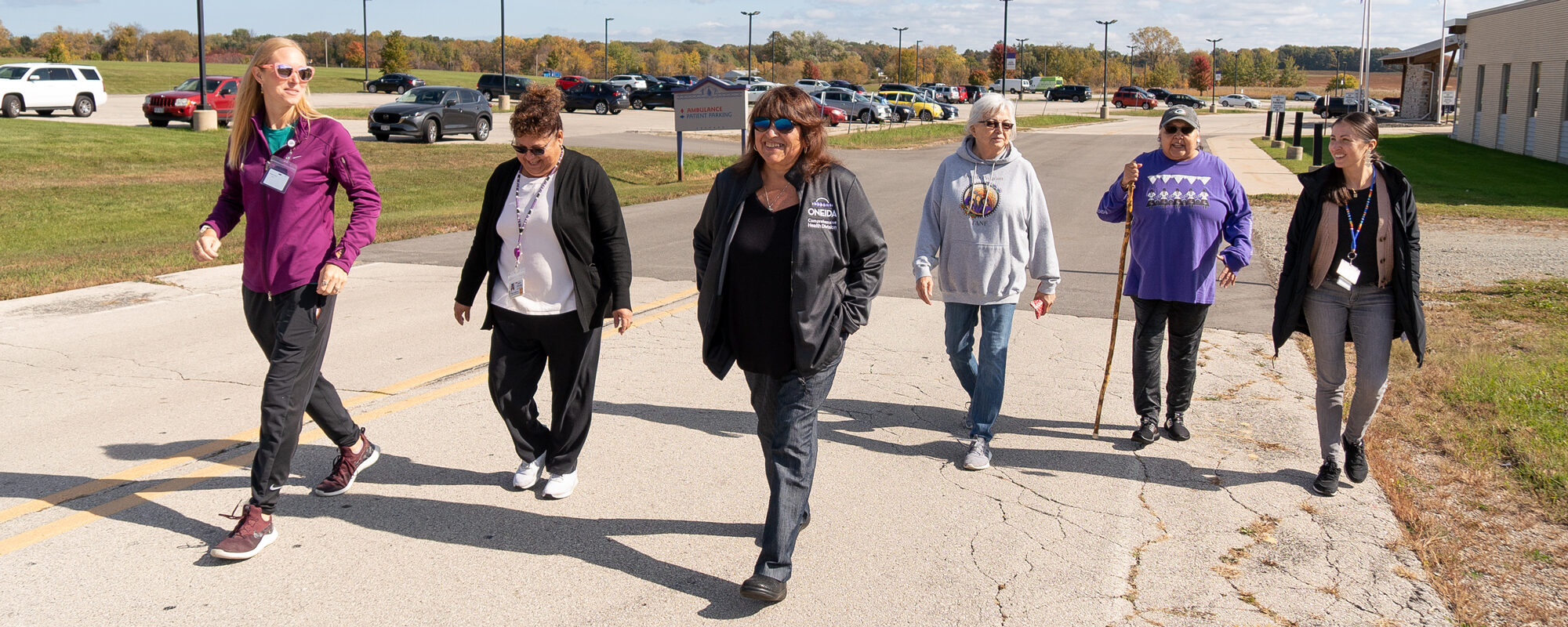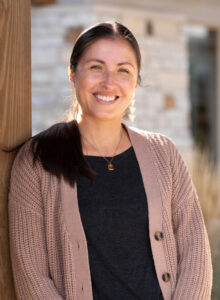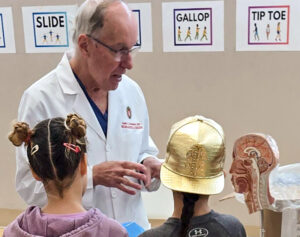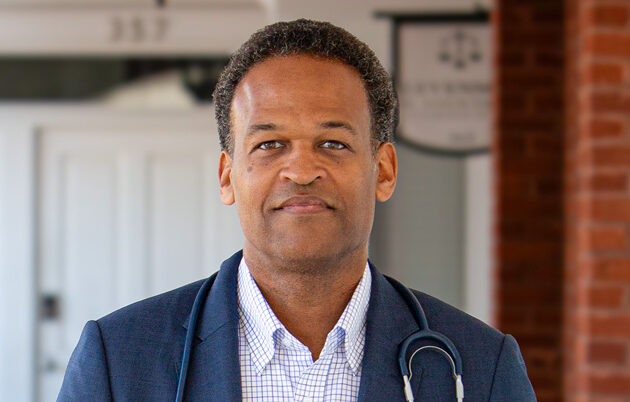
Community members in Oneida, Wisconsin, participate in a Heart Walk coordinated by Tribal health coaches.
Debra Danforth, director of the Oneida Comprehensive Health Division (OCHD) in Oneida, Wisconsin, says a joint project to improve stroke risk among Oneida Nation elders has been a win-win relationship on many levels.
It has measurably improved the health of elders in the Oneida community and has expanded connections and support to increase work with younger generations. It also has increased the number of Native American health care providers who are interested in working in Tribal health systems.
Most importantly, she says, the relationship has helped heal long-standing concerns regarding research within the Oneida community and improved working relationships with University of Wisconsin and other researchers in that community.
“This group has renewed our faith and trust in doing research with the university,” Danforth says. “The OCHD has worked hard to collaborate with the university in improving our communication [among] the researchers, the OCHD, and the community. This sets the model for future research initiatives not only within our community but throughout Indian Country. The stroke prevention team has the bar really high for any researcher who wants to come in and work with Oneida in the future. This includes respect to preserve our data sovereignty, as well as demonstrating respect for the Nation’s desire to maintain our control over our own data.”
The project, Preventing Stroke in the Oneida Nation, began in 2019 with a grant from the Wisconsin Partnership Program and is a joint effort of the Oneida Nation and the UW School of Medicine and Public Health (SMPH), led by co-principal investigators Robert Dempsey, MD, professor and chair, Department of Neurological Surgery, and Carol Mitchell, PhD, associate professor, Division of Cardiovascular Medicine, Department of Medicine. SMPH’s Native American Center for Health Professions (NACHP, pronounced as “nay-chip”) made the connection between the faculty members and the Oneida Nation leadership. Melissa Metoxen, NACHP assistant director, works out of NACHP’s Tribal Engagement Office at the Oneida Community Health Center on the Oneida Reservation.

“Many faculty members have not worked with Tribal communities, so my role is to educate and share information, making sure the Tribe’s best interests are at the forefront,” says Metoxen, a member of the Oneida Nation.
Dempsey has 40 years of experience in research on stroke, including working with Indigenous communities on five continents. He also is passionate about preventing the effects of major strokes that can devastate a person’s ability to speak or walk, as well as “silent strokes,” or transient ischemic attacks, which can cause vascular dementia. But during his early visits to the Oneida Nation, he was a student and a listener.
“You cannot assume you know more than the people involved because they have been working on this problem forever, and they are very aware of stroke risks and the interactions among smoking, obesity, and diabetes,” Dempsey says. “They have a very good health division, and we worked with them.”
Danforth remembers some early visits when the elders were skeptical.
“The elders asked a lot of tough questions; they wanted to know what benefits would come to the community,” she says. “And they could see that Dr. Dempsey was not just doing research, but that he wanted to make a difference.”
Tribal elders were not the only ones asking questions; every year, thanks to the partnership with NACHP, Native American medical students travel to Oneida to work on the project.
“The students question me carefully, asking why I am doing this and what my motivations are,” says Dempsey.
One motivation was that Native Americans who live on reservations have the highest stroke risk of any U.S. population, driven by diabetes, heart disease, generational trauma, and food insecurity. The first project assessed the stroke risk of 120 Tribal elders. Assisted by medical students, Dempsey performed medical exams, and Mitchell’s team did ultrasounds of community members’ carotid arteries to image the atherosclerotic plaque that can break loose and block blood flow to the brain, causing a stroke. Other professionals conducted cognitive exams.

Further, participants met health coach Amanda Riesenberg, who was hired as a Tribal employee using funding from the Wisconsin Partnership Program grant. She worked with elders to develop exercise and diet plans consistent with their culture and track their health improvements. Each participant received a detailed assessment of what they could do to improve their health; their primary care providers at the Oneida Community Health Center received copies.
Results from the project’s first phase, which are being submitted for publication, are encouraging, says Dempsey. In people who did the intervention with the health coach, ultrasounds show that progression of carotid artery blockages have slowed.
“As a group, they are lighter, their body mass index is better, their blood pressure is better, and their diabetes is under better control,” explains Dempsey, whose team also is analyzing levels of proteins made by fat cells, which may play a role in increasing stroke risk. “I believe this is the largest intervention study ever of stroke risk in Native Americans.”
Because the ultrasound screenings showed high levels of stroke risk in elders — 81 percent of participants had carotid artery blockages — the project entered a second phase. Researchers enrolled 85 adults from ages 35 to 55, and they found disease in that population, as well. Dempsey’s group has written five additional grant proposals to do more robust, earlier interventions, including health education for school-age children.
Danforth says her staff has appreciated the collegial support from the SMPH team and the fact that Dempsey and others have visited monthly, participating in Tribal health activities such as the “Walk with a Doctor” program, health fairs, and school-based education events.
“This project is not just for us now, but for future generations, as we look at the impact on the seventh generation,” Danforth says. Noting that a side benefit has been getting to know Native American medical students, she adds, “It has opened a pipeline for us to hire some of these students whom we otherwise would not know about.”
Meanwhile, SMPH Department of Neurological Surgery has hired its first Native American neurosurgery resident. American Indian enrollment at the SMPH has grown by 600 percent since 2014, with the school graduating 11 Native American medical students in 2024, its largest class of Indigenous students to date. Metoxen says, as of 2024, data from the Association of American Medical Colleges ranks the SMPH seventh out of the top 10 medical degree-granting institutions for current enrolled American Indian/Alaska Native students who self-identify alone and/or in combination with another race.
This has helped me get back to the basics and remember why I became a doctor in the first place.
- Robert Dempsey, MD
SMPH medical student Louden Akin grew up in Oklahoma as a member of the Osage and Cherokee Nations. Upon learning about the stroke project from NACHP staff, he was excited to volunteer, making trips to Oneida to conduct research and participate in education.
“Growing up, I received health care from the Indian Health Service, and now that I understand the cost of health care, I see the benefits of this service,” he says, adding that the stroke project has made him consider neurology as a career. “I think to be able to give back and serve our community would be very rewarding.”
Akin and others involved in the project believe it has a good chance of becoming self-sustaining after the grants end. Organizers hope to replicate the program in Wisconsin’s other Tribal Nations and help more individuals who are at risk of stroke, no matter their ethnicity.
“The lessons we are learning by studying the highest-risk population will benefit everyone,” Dempsey says. “We are learning that it is important how information is presented, how it is reinforced by peers in the community, and how it fits the culture. We have learned enormous lessons that are very practical for medical students about how to work with patients worldwide.”
And as much as the students have learned, Dempsey says he personally feels the benefits of working with the Oneida Nation. He concludes, “This has helped me get back to the basics and remember why I became a doctor in the first place.”

